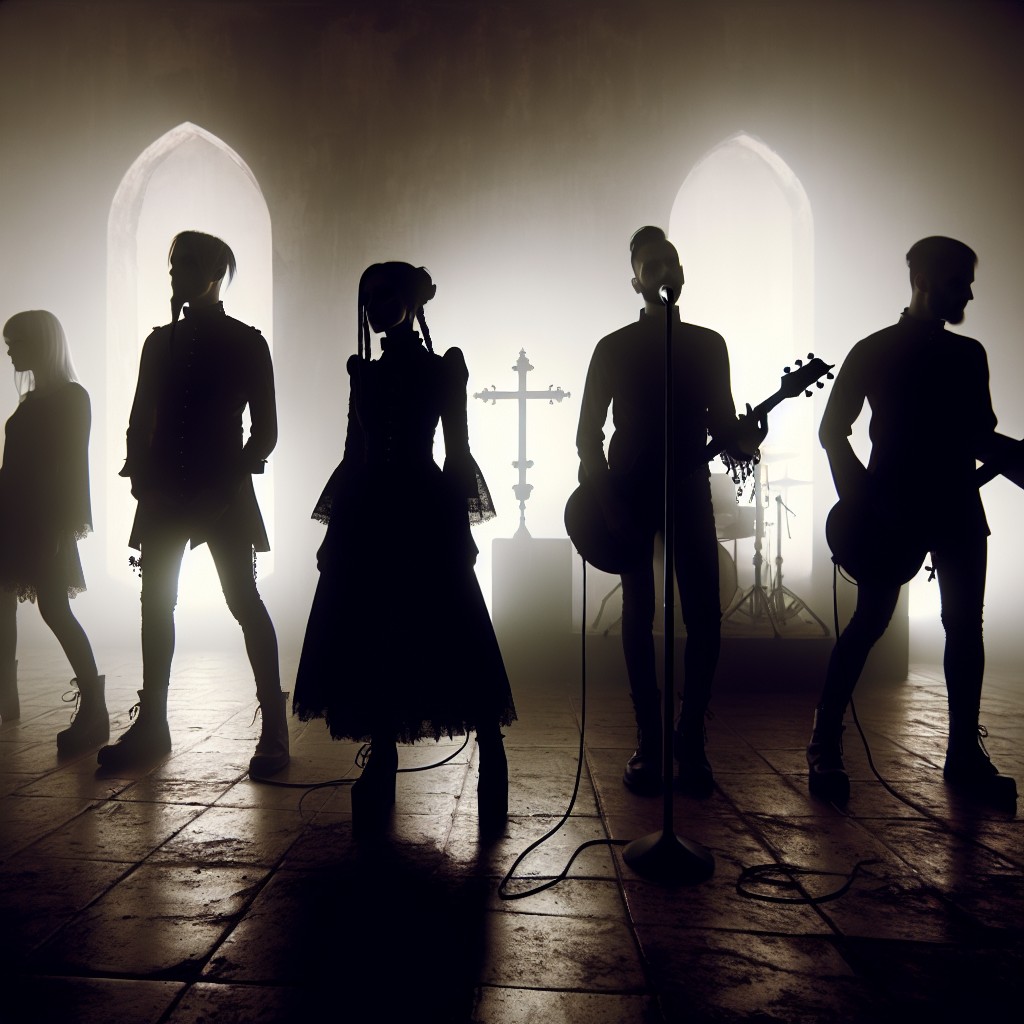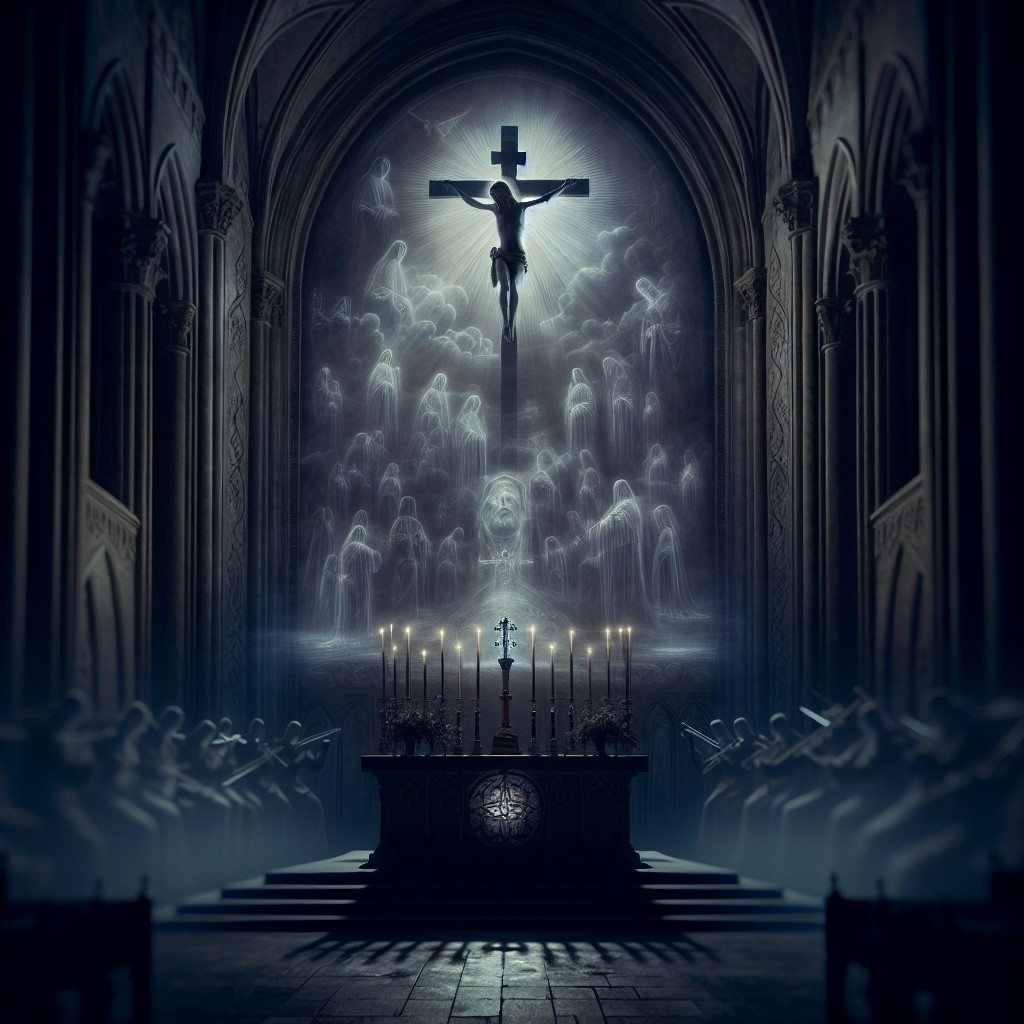Last updated on
Fans of the band Ghost might have second-guessed the meaning behind the hit “Mary on a Cross” because it brims with potential interpretations, all based on the band’s signature symbolic lyrics and mysterious ambiance.
Key takeaways:
- “Mary on a Cross” is a distinctive track in Ghost’s discography.
- The song explores themes of love, loss, and forbidden romance.
- The lyrics intertwine religious imagery with intense attachment and longing.
- The cross symbolizes sacrifice, suffering, and the burdens of love.
- The song invites varied interpretations and incites discussion among fans and critics.
Table of Contents
Background of Ghost and Their Musical Style

Formed in Sweden in 2006, the band Ghost (formerly known as Ghost B.C. in the United States) is renowned for their unique blend of heavy metal with melodic rock, often underpinned by progressive and psychedelic elements.
They cloak their performances in theatricality, with band members anonymized as Nameless Ghouls and fronted by a character known as Papa Emeritus, who is represented in different incarnations corresponding to each album era.
Ghost’s aesthetic and themes heavily draw from occult and horror movie motifs, juxtaposed with surprisingly accessible, often catchy melodies.
Their sound is distinct not only for its metal roots but also for incorporating a variety of influences from pop rock to liturgical music, creating a diverse and genre-spanning discography.
Overview of “Mary On a Cross” Within Ghost’s Discography

“Mary on a Cross” stands out as a distinctive track in the discography of the Swedish rock band Ghost. Released as part of a special double A-side single alongside “Kiss the Go-Goat,” it diverges from the band’s usual thematic content focused on Satanism and dark theology, exploring more personal themes of love and loss.
The single belongs to the ‘Seven Inches of Satanic Panic’ EP, which offers a nostalgic nod to the psychedelic rock era of the 1960s, unlike their typically heavy metal influence.
Despite its release in 2019, the song quickly found a resurgence in popularity, especially on social media platforms like TikTok, introducing the band to a new wave of listeners. It showcases Ghost’s versatility in blending catchy melodies with storytelling lyrics, further cementing their reputation for creating music that transcends a single genre.
The integration of pop sensibilities into their established rock sound in “Mary on a Cross” contributes to its memorability and widespread appeal.
Lyrical Breakdown of “Mary On a Cross”
Diving into the verses, “Mary on a Cross” unfolds a tale that intertwines romantic fervor with religious imagery. The lyrics, “We were on a deathbed, you had a dirty face,” suggest a relationship enduring hardship, possibly on the brink of demise. Yet, despite the struggle, there’s a clear expression of intense attachment and longing between the individuals.
The chorus amplifies this connection with the words, “If you choose to run away with me, I will tickle you internally,” hinting at an irresistible, albeit possibly forbidden, romance. The use of “internally” could imply a deep emotional bond beyond physical attraction.
Further poetic lines like, “And I see that you’re the first one in a line” and “You go down just like Holy Mary,” use religious connotations as metaphors for devotion and sacrifice. The juxtaposition of love against the backdrop of religious sacrifice offers a rich ground for interpretation, blending the sacred and the carnal in a narrative that challenges orthodox narratives of love.
Lastly, the recurring phrase, “Mary on a cross,” presents a compelling visual that could symbolize a multitude of things, from martyrdom and suffering to redemption and salvation within the context of a love story. By weaving together themes of passion with spiritual motifs, the song invites listeners to reflect on the complexities of love and devotion.
Analysis of the Verses
Delving into the verses of “Mary on a Cross,” one encounters a narrative steeped in metaphor and evocative imagery. These lines establish a protagonist who appears entangled in a love that defies conventional morals or religious boundaries. This love story is tainted with suffering and a plea for understanding that transcends time.
The lyrics juxtapose contemporary language with historical references, crafting a timeless setting for the tale.
References to Mary suggest a connection to religious figures, and yet, the portrayal twists the traditional narrative to explore more earthly relationships.
The verses often address a ‘you,’ implying a direct and personal connection with the subject of the song—a personified Mary who represents something more than a historical figure.
There’s a poetic allure to the imagery of being ‘together with you in a tomb,’ hinting at a romance that persists beyond death, challenging the idea of eternal consequence.
The tone of the lyrics oscillates between reverence and defiance, mirroring the internal conflict that accompanies forbidden desires.
Each verse layers the complexity of the emotions involved, giving depth to the characters and their connection.
The artful wording beckons listeners to ponder the depths of love and sacrifice, inviting interpretations that are as varied as the audience’s own experiences and beliefs.
Interpretation of the Chorus
The chorus of “Mary on a Cross” serves as a haunting centerpiece to the song, with its catchy melody juxtaposed against the gravity of its words. In it, the protagonist speaks directly to Mary, expressing a deep longing and a desire to be with her despite societal or ideological constraints.
There’s a sense of urgency and passion that can be interpreted as a reflection on the sacrifices one is willing to make for love. The repetition of the phrase “We would go down” emphasizes a mutual commitment to their bond, hinting at a readiness to face any downfall together.
This can also be seen as a metaphor for enduring scrutiny and judgment, drawing parallels to the biblical Mary’s own experiences with being misunderstood and judged. The use of the cross imagery not only ties into the band’s frequent religious references but might also symbolize a burden or a cross to bear, which in the context of the song, seems to be the love they share.
Themes of Forbidden Love and Desire in the Song
The track delves into the complexities of a love that society deems taboo, ill-fated, or simply wrong. Such emotions are often characterized by intensity and a sense of urgency, mirroring the trials the protagonists must overcome.
– Lyrics suggest a relationship that must be concealed, potentially because it crosses boundaries of social norms or religious doctrine.
The raw emotion in the song’s delivery emphasizes the fervor and passion of the lovers in the face of opposition.
It’s implied that the lovers might be willing to endure pain and sacrifice — symbolized by the cross — for the sake of their affections.
The juxtaposition of love and suffering invites listeners to question the nature of devotion and the sacrifices one might make in its name.
By employing the religious imagery of Mary and the cross, the song hints at a connection between the depth of religious devotion and the intensity of romantic desire.
In navigating the themes of forbidden love and desire, the song tells a tale as old as time, yet it’s refreshed through the lens of Ghost’s darkly romantic aesthetic.
Symbolism of Christianity and the Cross in the Lyrics
The use of Christian imagery in “Mary on a Cross” adds layers of complexity to the song’s meaning. The cross symbolizes sacrifice and suffering but also redemption and salvation. By placing Mary, a name often associated with purity and virtue, on this symbol of torment, the band invites listeners to consider a narrative that juxtaposes sanctity with subversion. This oxymoronic imagery may suggest the agony and ecstasy of love, especially love that defies conventional bounds.
Moreover, the reference to the cross may allude to the burden of unrequited or forbidden love, echoing the emotional trial one must endure for passion. Ghost often employs religious references to challenge established norms and provoke thought, and this track is no exception. The band uses these powerful symbols to open a dialogue on the nature of love, its place in human life, and how it often conflicts with cultural or religious mores.
Paradoxical Meanings and Dual Interpretations of the Song
Ghost’s “Mary on a Cross” effortlessly marries provocative imagery with the band’s signature theatrical flair, resulting in a trove of dual meanings that invite listeners to delve deeper.
The song can be perceived both as a lamentation of lost love and as a critique of religious dogma.
The title itself casts a strong historical image tied to sacrifice and atonement, yet in this modern context, it might represent the pains of a love that society deems sacrilegious or taboo.
The evocative lyrics play on the biblical narratives often found in Ghost’s music, reimagining them in a contemporary setting that could as easily speak to the trials of personal relationships as it does to broader spiritual themes.
The cross, typically a symbol of suffering and redemption, here might suggest the crucifixion of one’s personal desires, painting a picture of a love that endures in the face of adversity, even to the point of metaphorical martyrdom.
Each line of the song is laden with potential metaphor, encouraging a reflection on the dualities present in both faith and affection; the sacrilegious undertones serve as a reminder of the stark contrasts between the sacred and the profane, the celestial and the carnal.
Response and Interpretations By Fans and Critics
The song’s reception has seen a fascinating blend of interpretations. Fans have often praised its catchy melody juxtaposed with the darker undertones of the lyrics.
Some listeners embrace the song for its apparent storytelling, suggesting it narrates the tale of an impossible love, while others dive deeper, proposing it draws parallels with historical or biblical figures experiencing societal judgment.
Critics have highlighted Ghost’s skill in blending pop sensibilities with heavy metal themes, a blend that’s evident in this track. The artistic play with religious imagery has been noted as daring, yet it reflects the band’s established brand of philosophical and theological exploration through music.
Within music communities, discussion unfolds on forums and social media platforms, dissecting each lyric for hidden meanings. Some theorize the song is grounded in personal experience, transformed into an allegory by using religious symbolism; others speculate it’s a reflection on the human condition through the lens of history and scripture.
Regardless of the angle, the multifaceted responses to “Mary on a Cross” showcase the band’s success in crafting songs that resonate on multiple levels and incite conversation.
Song Credits and Contributing Artists
“Mary on a Cross” was released by the Swedish rock band Ghost, showcasing the creative vision of the group’s enigmatic leader, Tobias Forge. Forge, performing under the persona of a character named Papa Nihil for this song, is the primary songwriter and driving force behind the composition and conceptual elements of the track. His work is complemented by a team of talented producers and musicians that help bring the song to life.
The production quality reflects the meticulous care often invested in Ghost’s music, with attention to instrumentals that blend classic rock elements with a modern twist. Although specific session musicians aren’t always credited by name due to the band’s secretive nature, it is known that Ghost frequently collaborates with skilled industry professionals to achieve their distinctive sound. The blending of rich vocals, harmonious backing instruments, and atmospheric elements make “Mary on a Cross” a testament to the collective effort that is characteristic of Ghost’s music-making process.
The release is part of a double A-side single, which includes another hit, “Kiss The Go-Goat,” further reflecting Ghost’s genre-bending musical approach. It’s an exemplary showcase of the chemistry among contributing artists who, under Forge’s guidance, continue to push the boundaries of rock music.




